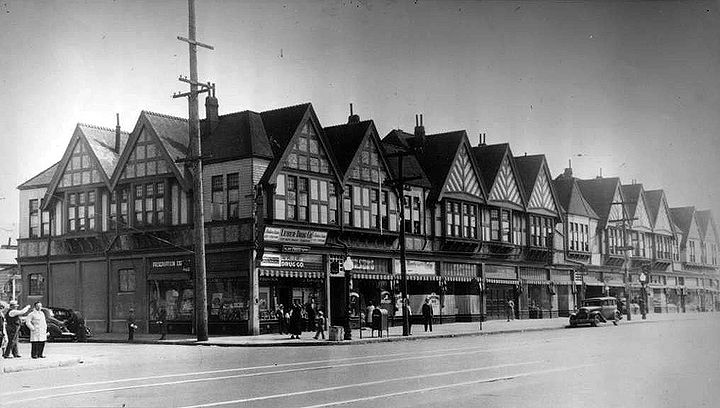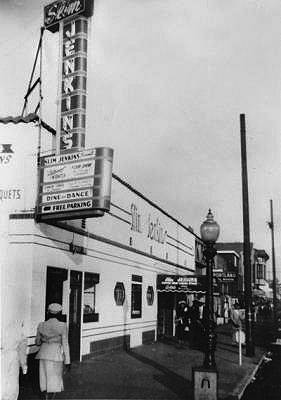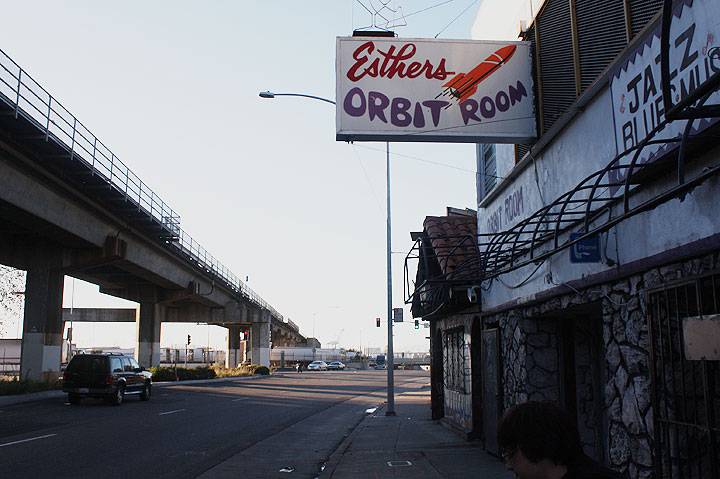The Rise and Fall of Seventh Street in Oakland
Historical Essay
by Jennifer Soliman, 2015
Neighborhood and business block of Seventh St., 1940s.
| More than any single event since its incorporation as a city in 1852, World War II transformed Oakland, notably West Oakland. One result of the influx of workers and economic vitality that the War brought to West Oakland was the development of Seventh Street as the neighborhood’s cultural centerpiece. In the 1940s and early 1950s, Seventh Street became a nationally reputed cultural haven for African-Americans. Jazz and blues musicians from around the country would perform in the Street’s myriad clubs producing a sound and scene known as the West Coast Blues. This article explores the factors that produced the Seventh Street heyday and the factors that, from the 1950s onward, created its economic and social demise. |
In the 1940s, West Oakland’s Seventh Street was hailed as a cultural haven for African-Americans. During the day, it served as a bustling place of commerce hosting a myriad of businesses such as markets, cleaners, restaurants, hotels and gyms. At night, its many nightclubs offered a thriving social scene that drew the hottest names in jazz from around the country. These clubs served as the seedbed that fostered the birth of West Coast Blues. Oakland’s specific location — at the junction of multiple modes of transportation — brought people from around the world to Oakland, especially Blacks from the South. It was these emigrants and immigrants who significantly contributed to the birth of Seventh Street. The ascent of Seventh Street’s prominence coincided with the emergence of a regional African-American middle class.
Even as the War-related jobs disappeared in the Bay Area, Seventh Street continued to thrive as a center of Black culture and commerce well into the 1950s.(1) What rung the knell of Seventh Street’s demise was federal intervention and modernization. West Oakland fell victim to urban renewal and other federal programs and initiatives that tore the Black neighborhood apart. Technological developments in transportation and in the shipyards led to a substantial loss of employment, and with it the paychecks that helped solidify Seventh Street. A substantial change in the social and economic landscapes ensued, and with it a deterioration of culture. What follows is an examination of the political and cultural factors that shaped the rise and decline of Seventh St in West Oakland.
West Oakland Before WWII
Before the completion of national railroads linked to the Bay Area, West Oakland served as a “suburban outpost” for San Francisco. Oakland had a total population of merely 1,543 residents in 1860.(2) The completion of the transcontinental railroad in 1869, which terminated in West Oakland, stimulated West Oakland’s economy and put the region on the national stage. An ethnically diverse work force was drawn to Oakland and the increasing employment opportunities provided by the railroad industry. By 1870, the population had jumped to 10,500 and, ten years later, further climbed to 34,555.(3) Blacks, Greeks, Latinos, Chinese, and Italians all found work and homes in West Oakland. Job opportunities ranged from delivery boys and laundry workers to engineers and sheet metal workers. Most African Americans found employment with the Pullman Palace Car Company. Despite being overqualified for the service sector positions, many Blacks worked as sleeping car porters, cooks, and waiters.(4) Only Black men were to serve as porters, as the Pullman Company believed it would sustain a natural divide between traveler and porter. In 1925, porters began organizing for union recognition and better working conditions. They chose Phillip Randolph, who had been fired for talk of unionization, to head the union with C. L. Dellums as Vice President, and soon the Brotherhood of Sleeping Car Porters was born. They then began a long campaign against Pullman. In 1937, Pullman admitted defeat and signed what became the very first contract between African-Americans and a corporation.(5) Nonetheless, porters were revered in their communities. As Ronald Dellums remembers, “they seemed like the astronauts of the Black community,” because they left the community and ventured into the world.(6) Railroad men would return with stories of what they saw and learned. In turn, they would take pieces of home and share them with world, which would later prove useful in disseminating the music and culture of Seventh St. Despite low wages in comparison to white workers, the Pullman Porters laid the groundwork for a solid middle class in the Black community. Working as a porter afforded Blacks an opportunity to partake in the American dream, to accumulate wealth and to purchase property.(7) People bought real estate, took new jobs, and opened businesses, many of which were located on Seventh St. This Black middle class became the backbone of Seventh Street and stimulated its heyday.
WWII and the Emergence of Seventh Street as a African-American Cultural Haven
World War II brought an infusion of federal spending that profoundly transformed the economy of the Bay Area and, with it, the Black middle class. The defense industries rapidly expanded as contracts were allotted for shipbuilding and the construction of the Oakland Army base and a Naval Supply Center.(8) The ports, docks, and railroads went into overdrive as materials were being transported to accommodate the new work. Labor was required at every level in nearly every field. With the thousands of men off to war, employers were not in a position to discriminate in hiring practices, thus employment was open to workers of both genders and all colors. As news of employment arose, people flooded into the Bay. Blacks from the South assured by family in California that jobs were plentiful poured in from the ports and the transcontinental line to Oakland. Although skilled and unskilled labor was needed, wartime managers would concentrate the new, migrant workers in fields of unskilled, low-wage labor. Blacks employed on docks, railroads, or in military supply centers, for example, found themselves disproportionately represented in lower level work. However, this was not the case on shipyards, which were largely composed of skilled or semi-skilled laborers. Managers altered the nature of the work shifting to an emphasis on prefabrication to enable newcomers to enter higher paid semiskilled work like welding, burning, and shipfitting.(9) With this increase in employment came an increase in disposable income, income that was spent on the commercial thoroughfare of Seventh Street.
The migrant Blacks that took residence in established black neighborhoods further consolidated the Black middle class. Because West Oakland was already home to an established Black population, Black migrants from the South were naturally drawn there. Due to housing shortages, many migrant families were taken in as boarders. Over time however, moving into West Oakland became less of a choice and more like the only option. As Oakland’s population grew exponentially, the population was well over 300,000 by 1940,(10) housing shortages became a pressing issue drawing federal attention. Funded by Congress, the Federal Housing Administration’s Title 6 program guaranteed loans for private construction, but was restricted to white buyers doing little to help those of color. Thus, white suburban neighborhoods arose, many of which were built outside of the city limit in an attempt to avoid municipal building codes. With little assistance from the private sector, Blacks remained in West Oakland and relied on public housing programs. Claims of racial conflict by Oakland Housing Authority, however, necessitated segregation of these programs. Four all-Black projects were built in West Oakland, while corresponding white projects were built along bay flats in East Oakland.(11) In her book, The Second Gold Rush, Marilynn Johnson proposes that segregation was implemented “in hopes of reducing interracial contacts and defusing tension” and was accepted in “in hopes of preserving social harmony through the war emergency.”(12) Nonetheless, the influx of Black migrants into West Oakland proved profitable for Seventh Street. They “formed the basis of new business,” according to Nathan Huggins,(13) that allowed merchants, landlords, and businesses owners on Seventh Street to prosper. Doctors, lawyers, and other professionals replaced the porters of the railroad era as the new Black middle class.
With a solid consumer base to support it, Seventh Street flourished. Southern Blacks brought with them the culture of owning property and soon both sides of Seventh Street became lined with cleaners, markets, groceries, liquor, furniture, pharmacies owned by Blacks. In KQED’s Crossroads: A Story of West Oakland, residents reminisce on the vibrancy of Seventh Street, how shoppers would walk down the street laughing and meet up with friends. Along the street “you would encounter any number of colorful local characters, such as ‘The Reverend' who, along with his wife, preached from street corners; the ‘Tamale Man', who pushed a cart up and down the street hawking his hot tamales to people pouring out of the clubs in the early morning hours; or Charles ‘Raincoat Jones', a former bootlegger turned loan shark and dice game operator, who was known as the unofficial mayor of Seventh Street and helped finance some of the jazz and blues clubs.”(14) There were also pool halls, gambling halls, and places to eat southern-style foods like Sylester Sim’s Overland Cafe. Ads in the window boasted, “Just like mother used to fix it” and “No fancy French names for our dishes.”(15)
The epitome of Seventh Street, however, was its nightlife and its music. Dance halls, theaters, cafes and clubs lined the street. The majority of West Oakland’s jazz clubs were found on Seventh Street, more than fifteen by the mid-1940s. Growth of the entertainment industry in Oakland was due to the influx of people with paychecks and appetites for fun. There was a club for everyone on the socioeconomic scale. Because Black musicians were not allowed into the Local 6 of the American Federation of Musicians, they were prevented from playing in clubs in downtown Oakland .(16) Seventh Street became the place to play, and play they did! Styles like New Orleans, swing, bebop, and blues could be heard up and down the street. Migrants brought with them a musical style that was rooted in the South, which lent elements to a new style called the West Coast Blues. It had “slow, draggier beat and a kinda mournful sound ”(17) compared to that of Chicago. To hear the West Coast Blues, the place to be was Slim Jenkin’s, the most renowned club on the West Coast. It attracted a mixed clientele and the hottest names in jazz and blues like Nat King Cole, B.B. King, Charles Brown, The Ink Spots, Aretha Franklin, Duke Ellington, and Sarah Vaughan. Lines would bend around the corner, while taxis zipped in and out filled with people waiting to listen to Jenkin’s next big act.
The Economic and Cultural Destruction of Seventh Street
The tides soon turned against Seventh Street, decimating the Black neighborhoods and middle class that constituted the vibrant street. Overcrowded neighborhoods, which began as a temporary wartime necessity, became an economic one as hundreds of people lost their jobs after the War boom .(18) Crowding in West Oakland’s neighborhoods led to deterioration and increased crime and violence, which became labeled as “slums” and “blighted” by local officials. To prevent the rest of Oakland from falling under the cancerous nature of blight, officials pushed for redevelopment and urban renewal. With this came an unequal redistribution of capital and a new form of racial segregation, a trend that swept the nation (for more information see: *link from foundsf*). The Housing Act of 1949, under eminent domain, condemned to destruction the homes of Blacks that had fallen to disrepair. Dozens of blocks of homes were bulldozed to the ground to make room for housing projects like Acorn, which alone displaced approximately nine thousand residents. Four hundred more homes and business were demolished in 1960 to make room for the construction of a U.S Postal Service distribution center .(19) The Black residents that were once pushed into West Oakland were now being forced out, taking with them the wealth and culture that created the allure of Seventh Street.
BART tracks dominate the 7th Street corridor in this 2013 photo.
Photo: via Art In the Margins blog
Slowly, Seventh Street lost its luster. As capital left West Oakland, employment diminished. The end of the War meant that fewer ships were needed and yards soon closed down. The emergence of “containers” on the ports displaced the multitudes of longshoremen that unloaded cargo. They were replaced by cranes that could unload entire boxcar sized trailers. A more extensive history of containerization can be found here. Travelers were no longer enchanted by the railroads, as the use of cars became more prominent. Because of the changes in the shipyards and railroads, thousands became unemployed. With the loss of jobs, came the loss of luster on Seventh Street. Without the sustenance of the steady flow of Black income, businesses closed their doors. The nightclubs that had once lined the street shut down or converted into neighborhood bars. Seventh Street became even more unappealing, with the construction of an overpass for the Cypress Freeway that sliced through it. The construction of BART was another heavy blow to Seventh Street. Unlike other stations, the BART station built in West Oakland was above ground with elevated tracks running straight through Seventh Street. The overpass killed the street. “Nobody wanted to go there with that thing running over your head all day long. ”(20) Shoppers stopped shopping, musicians stopped playing, and the life of Seventh Street was snuffed out. By the mid-1960s, the glamor of Seventh Street was all but forgotten.
Today, the Street is marked by boarded buildings and empty lots. Few signs remain of the vitality it once exuded. There are plans to revitalize West Oakland, notably the West Oakland Specific Plan, which has been approved by the Oakland City Council. Many community members fear that this approach to development will gentrify the area and displace longstanding residence. Others argue that the investment it will draw gives hope that a thoroughfare similar to Seventh Street will once again arise as a cultural haven for African Americans. For a glimpse of Seventh Street’s glamor, however, a virtual preservation of it can be found on the Remembering Seventh Street site.
Notes
1. Joshua Shapiro, “Shipyards and Sounds.” Infinite City: A San Francisco Atlas, 62
2. U.S Census of 1860
3. U.S Census of 1870 and 1880, respectively
4. Crossroads : A story of West Oakland. (1996; Quest Productions, video).
5. Thomas and Wilma Tramble, The Pullman Porters and West Oakland (Charleston, SC: Arcadia Publishing, 2007), 12-16
6. Crossroads: A Story of West Oakland
7. Tramble, The Pullman Porters and West Oakland, 21
8. Robert Douglass, “A Brief History of West Oakland” (pdf) Olmsted and Olmsted (1994), 40.
9. Marilynn Johnson, The Second Gold Rush (London: University of California Press, 1993), 61-65
10. U.S Census of 1940
11. Johnson, The Second Gold Rush, 93-106
12. Johnson, The Second Gold Rush, 106
13. Johnson, The Second Gold Rush, 96
14. Yehuda E. Kalay and Paul Grabowicz, Virtual Preservation of Seventh Street's 1950s Jazz, (accessed 30 April 2015).
15. Willie Collins, “Jazzing up Seventh Street : musicians, venues, and their social implications.” Sights and Sounds Essays in Celebration of West Oakland. (Oakland, CA, 1997), 302
16. Collins, “Jazzing up Seventh Street,” 302
17. DjeDje, Jacqueline Cogdell., and Eddie S. Meadows, “Oakland Blues." California Soul: Music of African Americans in the West (Berkeley: University of California Press, 1998), 107.
18. Collins, “Jazzing up Seventh Street,” 322
19. Robert Self “Redistribution.” American Babylon: Race and the Struggle for Post-War Oakland, (Princeton: Princeton University Press, 2003), 137-141
20. Crossroads : A story of West Oakland



